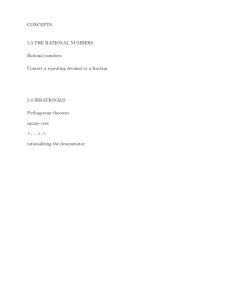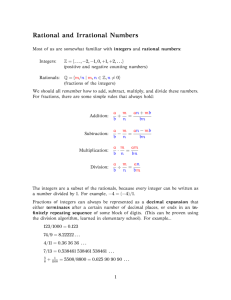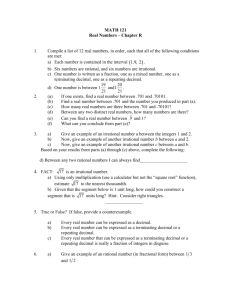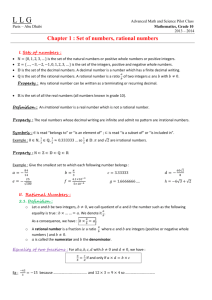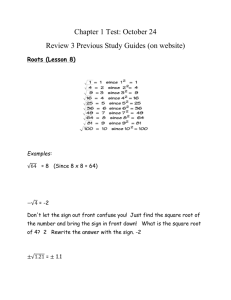Types of Decimal Numbers - Rational and Irrational Numbers
advertisement
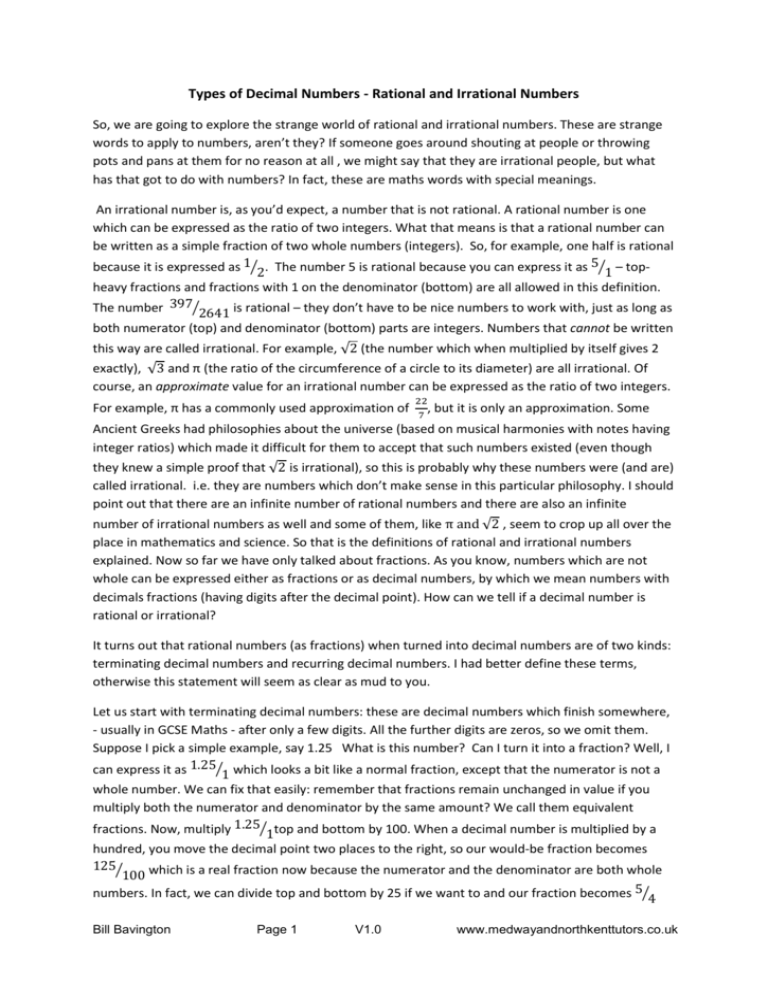
Types of Decimal Numbers - Rational and Irrational Numbers So, we are going to explore the strange world of rational and irrational numbers. These are strange words to apply to numbers, aren’t they? If someone goes around shouting at people or throwing pots and pans at them for no reason at all , we might say that they are irrational people, but what has that got to do with numbers? In fact, these are maths words with special meanings. An irrational number is, as you’d expect, a number that is not rational. A rational number is one which can be expressed as the ratio of two integers. What that means is that a rational number can be written as a simple fraction of two whole numbers (integers). So, for example, one half is rational because it is expressed as . The number 5 is rational because you can express it as – top- heavy fractions and fractions with 1 on the denominator (bottom) are all allowed in this definition. The number is rational – they don’t have to be nice numbers to work with, just as long as both numerator (top) and denominator (bottom) parts are integers. Numbers that cannot be written this way are called irrational. For example, (the number which when multiplied by itself gives 2 exactly), and π (the ratio of the circumference of a circle to its diameter) are all irrational. Of course, an approximate value for an irrational number can be expressed as the ratio of two integers. For example, π has a commonly used approximation of , but it is only an approximation. Some Ancient Greeks had philosophies about the universe (based on musical harmonies with notes having integer ratios) which made it difficult for them to accept that such numbers existed (even though they knew a simple proof that is irrational), so this is probably why these numbers were (and are) called irrational. i.e. they are numbers which don’t make sense in this particular philosophy. I should point out that there are an infinite number of rational numbers and there are also an infinite number of irrational numbers as well and some of them, like π and , seem to crop up all over the place in mathematics and science. So that is the definitions of rational and irrational numbers explained. Now so far we have only talked about fractions. As you know, numbers which are not whole can be expressed either as fractions or as decimal numbers, by which we mean numbers with decimals fractions (having digits after the decimal point). How can we tell if a decimal number is rational or irrational? It turns out that rational numbers (as fractions) when turned into decimal numbers are of two kinds: terminating decimal numbers and recurring decimal numbers. I had better define these terms, otherwise this statement will seem as clear as mud to you. Let us start with terminating decimal numbers: these are decimal numbers which finish somewhere, - usually in GCSE Maths - after only a few digits. All the further digits are zeros, so we omit them. Suppose I pick a simple example, say 1.25 What is this number? Can I turn it into a fraction? Well, I can express it as which looks a bit like a normal fraction, except that the numerator is not a whole number. We can fix that easily: remember that fractions remain unchanged in value if you multiply both the numerator and denominator by the same amount? We call them equivalent fractions. Now, multiply top and bottom by 100. When a decimal number is multiplied by a hundred, you move the decimal point two places to the right, so our would-be fraction becomes which is a real fraction now because the numerator and the denominator are both whole numbers. In fact, we can divide top and bottom by 25 if we want to and our fraction becomes Bill Bavington Page 1 V1.0 www.medwayandnorthkenttutors.co.uk which is, as we say ‘expressed in its lowest terms’. You probably knew that 1.25 = 1¼ = 5/4 anyway, but this gives you a general method to convert a decimal number to an equivalent fraction. The point is, as far as rational or irrational is concerned, we don’t need to go this far, simply saying that is enough to show that it is a rational number. This two-step method obviously works for any terminating decimal number :Step 1. However many decimal digits the number has, make it into a fraction by putting it over (a denominator) of 1. Step 2. Then multiply the numerator and denominator by a big enough power of ten ( that is, a 1 followed by enough zeros) to make the numerator a whole number and multiply the denominator by the same power of ten to keep the fraction equivalent. You can also think of the multiplication as the process of moving the decimal point the same number of places to the right, to both top and bottom numbers. e.g. , This is why we can say any terminating decimal number is rational. A recurring decimal number is one in which some pattern of digits repeats in the decimal fraction part forever. It can be simple, like 0.33333333.... where just a 3 repeats or more something more complicated like 2.357268268268..... where after the digits ‘357’ a pattern of ‘268’ repeats forever. There is a special notation for these recurring decimals. For a single digit repeat, a dot is placed over the repeating digit, for repeat patterns, one dot is placed over the digit at the start of the pattern and a second dot on the last digit of the pattern. So for our two examples above, and You probably already know that Now 1 and 3 are commonplace enough numbers, so you are probably wondering why does off to infinity. The reason have such a horrid decimal form, with all these digits going has this endless string of 3s in the decimal fraction is because of our base-10 number system – no power of ten (that is 10 , 100, 1000 and so on - no matter how big you go) is divisible by 3 exactly (without a remainder). So if you divide 1 by 3 by long or short division, you get ‘3 into 10 goes 3, remainder 1, carry the remainder and put it onto the next 0 to make 10, then 3 into 10 goes....’ and so on every step so that the process of division goes on forever. Now, if other numbers appear in the denominator of the fraction, such as 7, 11 or 13 say (or numbers which are multiples of 7, 11... like 14 or 33 say) which are numbers not exactly divisible into any power of ten, then when the division is performed, a cycle of remainders is obtained, giving a repeat pattern of digits in the decimal fraction. So, for example, and and for a more obscure one, The best way to satisfy yourself of this is to try out some long or short divisions (the hard way, by hand, not on a calculator) on these sorts of fractions. Bill Bavington Page 2 V1.0 www.medwayandnorthkenttutors.co.uk So we have found that some rational numbers turn into terminating decimal numbers and some into recurring decimal numbers . This leaves just one group of decimal numbers unaccounted for, those that go on forever, like recurring decimals, but unlike them in that they never repeat themselves in a pattern. These are, in fact the irrational numbers - like digits of π are :- and π. Now, the first 100 3.1415926535897932384626433832795028841971693993751058209749445923078164062862089 986280348253421170679... If you look through these digits, you’ll see that there is no repeating pattern in them. What if you were to try and accurately express this irrational number as a fraction? Well, for it to be accurate you would need every decimal digit of π to be included. So you would have to start by writing π as a fraction with the - with the infinite number of digits - it’s going to take you a long time! Then you would have to move the decimal point in the decimal form of π from between the 3 and the 1 an infinite number of decimal places to the right to make it a whole number and so the denominator would become a 1 followed by an infinite series of 0s just to keep the fraction equivalent (doing the same thing top and bottom). Since both these numbers go on forever, both are infinitely big and the fraction would be just (that is, infinity divided by infinity) which is undefined and basically, this is another way of saying it is meaningless (in this context). In short, then you just can’t express π as a ratio of two integers - it is an irrational number as we said earlier. Similarly, all numbers which have decimal fractions that go on forever and never repeat as a pattern are irrational. To summarise, then :- A rational number can be expressed as the ratio of two integers. or in other words, as a simple fraction. Expressed as a decimal number it either terminates, or repeats a pattern of digits forever. An irrational number is one which is not rational, so cannot be expressed as the ratio of two integers. It could be expressed as a decimal number, with the digits following the decimal point going on forever, but forming no repeating pattern. In consequence, since we cannot actually write down an infinite number of decimal digits, any decimal form of this number that we can write down will only ever be an approximation to the number. Try to be rational. -1 Huh! Just get real*. ne is an imaginary number. * The square root of minus one is an imaginary number. Bill Bavington Page 3 V1.0 www.medwayandnorthkenttutors.co.uk
